On the Analyses of Cure Cycle Effects on Peel Strength Characteristics in Carbon High-Tg Epoxy/Plasma-Activated Carbon PEEK Composite Interfaces: A Preliminary Inquiry
Abstract
1. Introduction
2. Experimental Details
2.1. Materials
2.2. Plasma Treatment
2.3. Co-Curing Process
2.4. Peel Tests
3. Results and Discussion
3.1. Peel Tests
- Initially, there’s an increase in peeling force until the interface starts to propagate.
- Once the interface begins to propagate, there’s a slight drop in peeling force. As cracks propagate between adhered materials, the effective load transfer diminishes, resulting in a reduction in peeling force. It is important to note that Xu et al. (1992) [41] characterized a viscoelastic plate resembling a cantilever beam subjected solely to bending. Their findings indicate that interfacial toughness initially rises and subsequently declines with an increase in crack propagation velocity. This implies the potential presence of peak viscoelastic energy dissipation occurring at an intermediate crack velocity [42].
- This is followed by a peeling process where the peeling force stabilises, represented by the average force during peeling (indicated by dashed red lines in Figure 3) in our experiments.
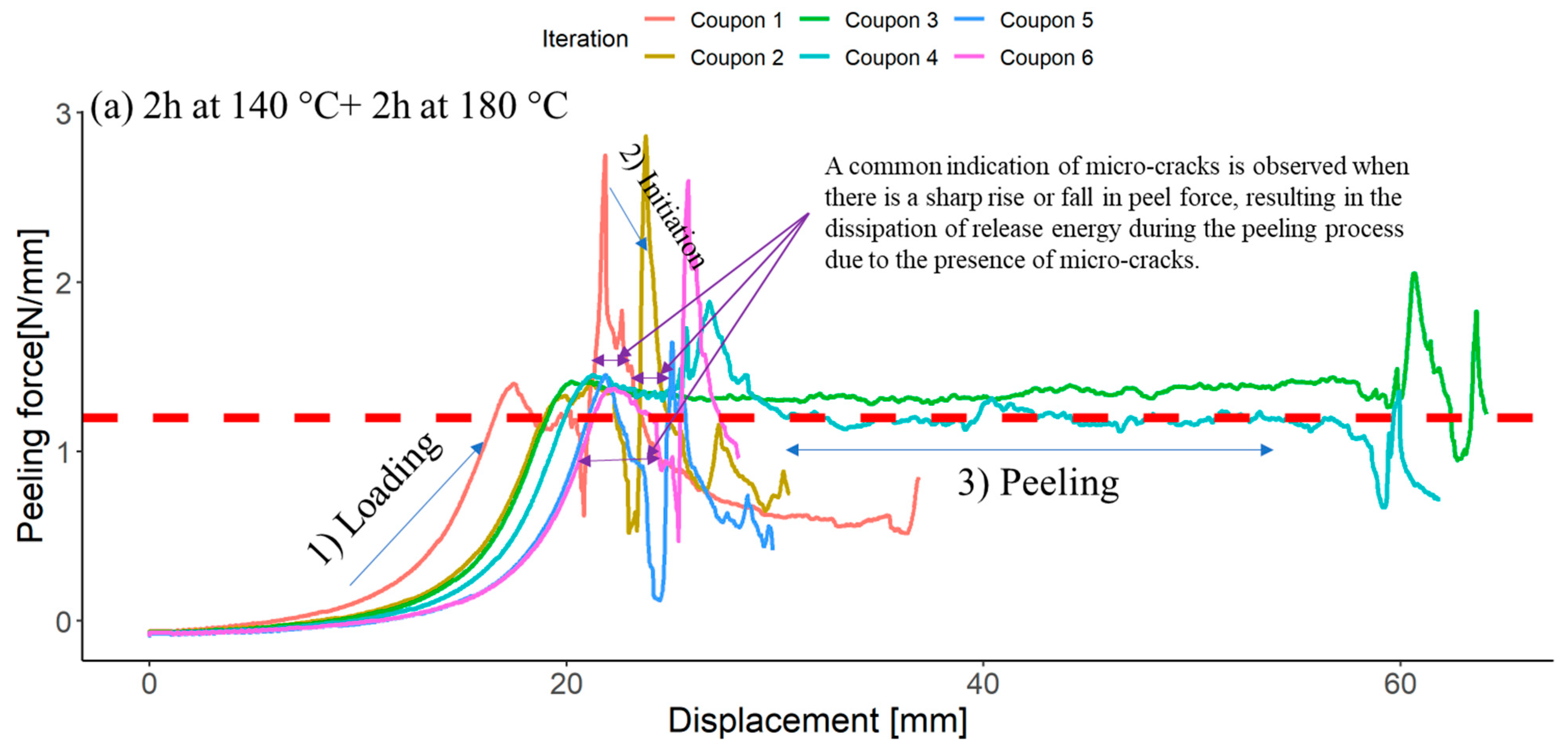
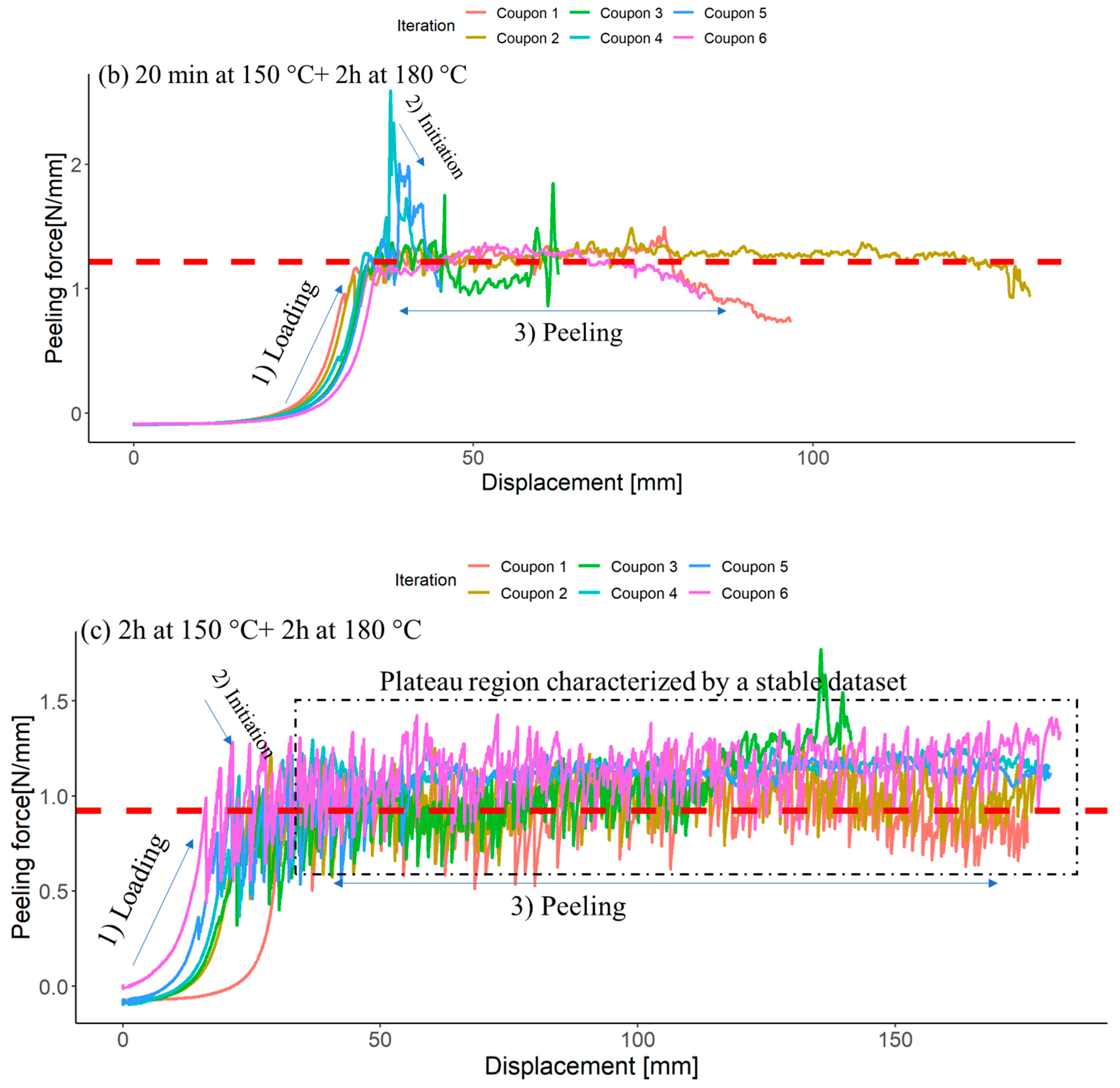
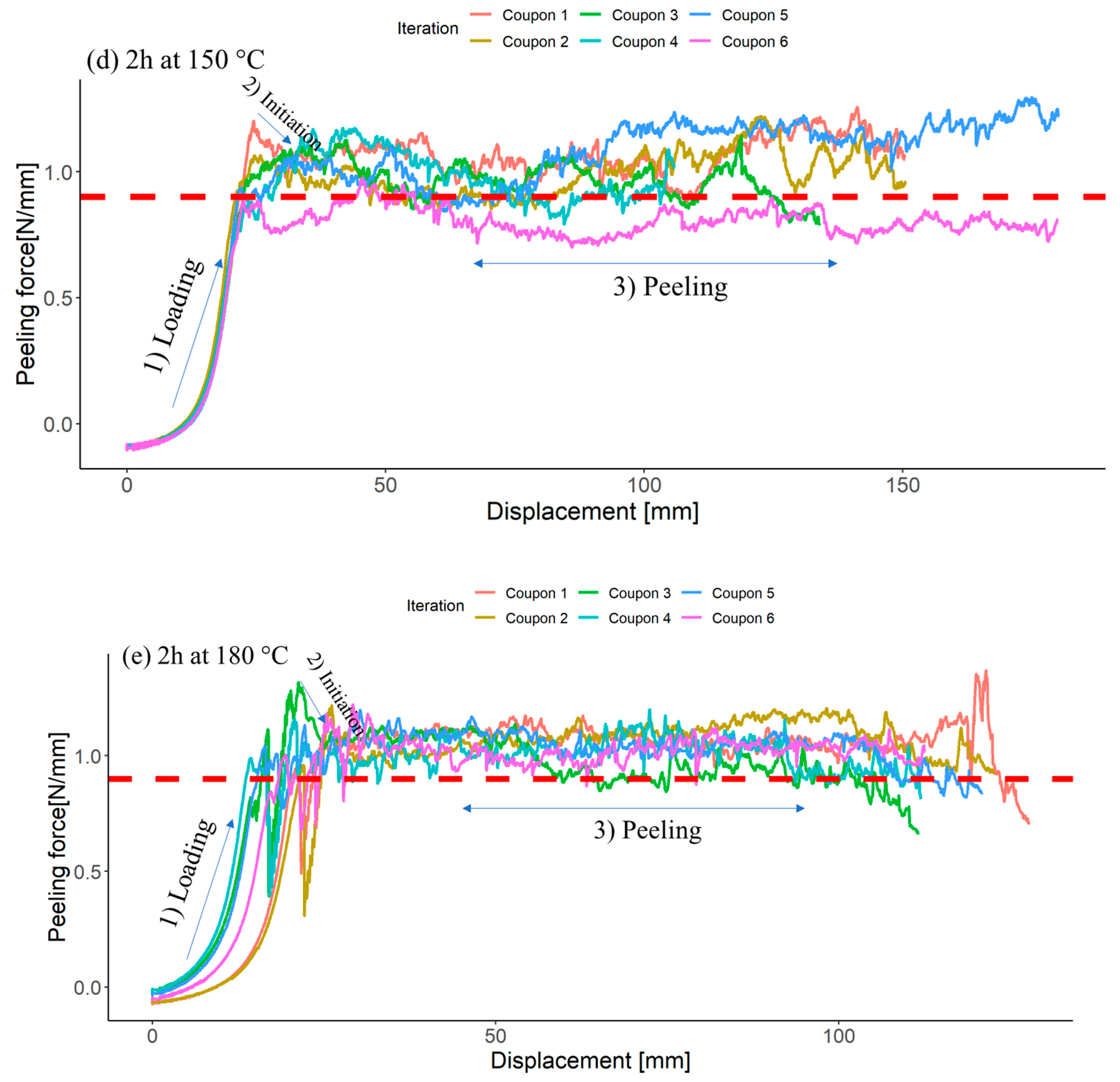
3.2. Microscopic Investigation of the Interfaces of the Joints
4. Conclusions
- (1)
- The curing cycle exerts influential contributions to thebonding characterisation of co-cured interfaces of PEEK/RTM6. The results showed that curing temperature and time are of high importance, and hence the peeling test results do help in understanding which cure cycles can lead to strong bonds between PEEK/RTM6.
- (2)
- While peeling force for the cure cycle of 2 h at 140 °C + 2 h at 180 °C showed higher values in some of the iterations, the curing cycle of 2 h at 150 °C + 2 h at 180 °C showed reproducible results, and the adhesion between PEEK and RTM6 tends to be more stable.
Funding
Institutional Review Board Statement
Informed Consent Statement
Data Availability Statement
Acknowledgments
Conflicts of Interest
References
- Chawla, K.K. Composite Materials; Springer Science and Business Media LLC: Dordrecht, The Netherlands, 2019; ISBN 9783030289829. [Google Scholar]
- Yousefpour, A.; Hojjati, M.; Immarigeon, J.-P. Fusion Bonding/Welding of Thermoplastic Composites. J. Thermoplast. Compos. Mater. 2004, 17, 303–341. [Google Scholar] [CrossRef]
- Villegas, I.F.; van Moorleghem, R. Ultrasonic welding of carbon/epoxy and carbon/PEEK composites through a PEI thermoplastic coupling layer. Compos. Part A Appl. Sci. Manuf. 2018, 109, 75–83. [Google Scholar] [CrossRef]
- Otheguy, M.; Gibson, A.; Robinson, A. Fusion bonding of structural T-joints for thermoplastic composite boats. J. Thermoplast. Compos. Mater. 2013, 26, 419–442. [Google Scholar] [CrossRef]
- Ahmed, T.; Stavrov, D.; Bersee, H.; Beukers, A. Induction welding of thermoplastic composites—An overview. Compos. Part A Appl. Sci. Manuf. 2006, 37, 1638–1651. [Google Scholar] [CrossRef]
- Panneerselvam, K.; Aravindan, S.; Haq, A.N. Study on resistance welding of glass fiber reinforced thermoplastic composites. Mater. Des. 2012, 41, 453–459. [Google Scholar] [CrossRef]
- Stavrov, D.; Bersee, H. Resistance welding of thermoplastic composites-an overview. Compos. Part A Appl. Sci. Manuf. 2005, 36, 39–54. [Google Scholar] [CrossRef]
- Van Ingen, J.W. Thermoplastic Orthogrid Fuselage Shell. SAMPE 2016, 52, 7–15. Available online: https://www.researchgate.net/publication/307926694 (accessed on 19 October 2023).
- Ageorges, C.; Ye, L.; Hou, M. Advances in fusion bonding techniques for joining thermoplastic matrix composites: A review. Compos. Part A Appl. Sci. Manuf. 2001, 32, 839–857. [Google Scholar] [CrossRef]
- Villegas, I.F.; Moser, L.; Yousefpour, A.; Mitschang, P.; Bersee, H.E. Process and performance evaluation of ultrasonic, induction and resistance welding of advanced thermoplastic composites. J. Thermoplast. Compos. Mater. 2013, 26, 1007–1024. [Google Scholar] [CrossRef]
- Amend, P.; Frick, T.; Schmidt, M. Experimental Studies on Laser-based Hot-melt Bonding of thermosetting Composites and Thermoplastics. Phys. Procedia 2011, 12, 166–173. [Google Scholar] [CrossRef]
- Ageorges, C.; Ye, L. Resistance welding of thermosetting composite/thermoplastic composite joints. Compos. Part A Appl. Sci. Manuf. 2001, 32, 1603–1612. [Google Scholar] [CrossRef]
- Van Ingen, J.W.; Buitenhuis, A.; Van Wijngaarden, M.; Simmons, F. Development of the Gulfstream G650 induction welded thermoplastic elevators and rudder. In Proceedings of the International SAMPE Symposium and Exhibition, Seattle, WA, USA, 18–21 May 2010. [Google Scholar]
- Deng, S.; Djukic, L.; Paton, R.; Ye, L. Thermoplastic–epoxy interactions and their potential applications in joining composite structures—A review. Compos. Part A Appl. Sci. Manuf. 2015, 68, 121–132. [Google Scholar] [CrossRef]
- Yuan, X.; Jayaraman, K.; Bhattacharyya, D. Effects of plasma treatment in enhancing the performance of woodfibre-polypropylene composites. Compos. Part A Appl. Sci. Manuf. 2004, 35, 1363–1374. [Google Scholar] [CrossRef]
- Perrin, H.; Mertz, G.; Senoussaoui, N.-L.; Borghini, L.; Klein, S.; Vaudemont, R. Surface functionalization of thermoset composite for infrared hybrid welding. Funct. Compos. Mater. 2021, 2, 10. [Google Scholar] [CrossRef]
- Renart, J.; Costa, J.; Sarrado, C.; Budhe, S.; Turon, A.; Rodríguez-Bellido, A. Mode I fatigue behaviour and fracture of adhesively-bonded fibre-reinforced polymer (FRP) composite joints for structural repairs. In Fatigue and Fracture of Adhesively-Bonded Composite Joints; Elsevier: Amsterdam, The Netherlands, 2015; pp. 121–147. [Google Scholar] [CrossRef]
- Wu, W.; Abliz, D.; Jiang, B.; Ziegmann, G.; Meiners, D. A novel process for cost effective manufacturing of fiber metal laminate with textile reinforced pCBT composites and aluminum alloy. Compos. Struct. 2014, 108, 172–180. [Google Scholar] [CrossRef]
- Wu, W.; Klunker, F.; Xie, L.; Jiang, B.; Ziegmann, G. Simultaneous binding and ex situ toughening concept for textile reinforced pCBT composites: Influence of preforming binders on interlaminar fracture properties. Compos. Part A Appl. Sci. Manuf. 2013, 53, 190–203. [Google Scholar] [CrossRef]
- Fu, X.; Wu, X.; Huang, G.; Li, W.; Kang, S.; Wang, L.; Luo, J.; Pan, Z.; Lu, W. Fusion Bonding Possibility for Incompatible Polymers by the Novel Ultrasonic Welding Technology: Effect of Interfacial Compatibilization. ACS Omega 2022, 7, 14797–14806. [Google Scholar] [CrossRef]
- Moretti, L.; Olivier, P.; Castanié, B.; Bernhart, G. Experimental study and in-situ FBG monitoring of process-induced strains during autoclave co-curing, co-bonding and secondary bonding of composite laminates. Compos. Part A Appl. Sci. Manuf. 2021, 142, 106224. [Google Scholar] [CrossRef]
- Hasan, Z.; Rader, J.; Olson, A.; Turpin, D.; Onge, R.S.; Amback, J. Design, analysis and fabrication of thick co-cured wing structures. Compos. Part B Eng. 2019, 177, 107335. [Google Scholar] [CrossRef]
- Mohan, J.; Ivanković, A.; Murphy, N. Mixed-mode fracture toughness of co-cured and secondary bonded composite joints. Eng. Fract. Mech. 2015, 134, 148–167. [Google Scholar] [CrossRef]
- Kim, G.-H.; Choi, J.-H.; Kweon, J.-H. Manufacture and performance evaluation of the composite hat-stiffened panel. Compos. Struct. 2010, 92, 2276–2284. [Google Scholar] [CrossRef]
- Dhilipkumar, T.; Rajesh, M. Enhancing strength and stiffness of composite joint through co-cure technique. Compos. Commun. 2021, 27, 100878. [Google Scholar] [CrossRef]
- Quan, D.; Zhao, G.; Scarselli, G.; Alderliesten, R. Co-curing bonding of carbon fibre/epoxy composite joints with excellent structure integrity using carbon fibre/PEEK tapes. Compos. Sci. Technol. 2022, 227, 109567. [Google Scholar] [CrossRef]
- Shi, H.; Sinke, J.; Benedictus, R. Surface modification of PEEK by UV irradiation for direct co-curing with carbon fibre reinforced epoxy prepregs. Int. J. Adhes. Adhes. 2017, 73, 51–57. [Google Scholar] [CrossRef]
- Kosmachev, P.; Alexenko, V.; Bochkareva, S.; Panin, S. Deformation Behavior and Fracture Patterns of Laminated PEEK- and PI-Based Composites with Various Carbon-Fiber Reinforcement. Polymers 2021, 13, 2268. [Google Scholar] [CrossRef]
- Yao, C.; Qi, Z.; Chen, W.; Zhang, C. Experimental study on CF/PEEK thermoplastic fastener: Effects of fastener matrix crystallinity and fibre content on the strength of single-lap joint. Compos. Part B Eng. 2021, 213, 108737. [Google Scholar] [CrossRef]
- Kosmachev, P.V.; Panin, S.V.; Panov, I.L.; Bochkareva, S.A. Surface Modification of Carbon Fibers by Low-Temperature Plasma with Runaway Electrons for Manufacturing PEEK-Based Laminates. Materials 2022, 15, 7625. [Google Scholar] [CrossRef]
- Wu, Z.; Yi, X.-S.; Wilkinson, A. Interlaminar fracture toughness of carbon fibre/RTM6-2 composites toughened with thermoplastic-coated fabric reinforcement. Compos. Part B Eng. 2017, 130, 192–199. [Google Scholar] [CrossRef]
- Zotti, A.; Elmahdy, A.; Zuppolini, S.; Borriello, A.; Verleysen, P.; Zarrelli, M. Aromatic Hyperbranched Polyester/RTM6 Epoxy Resin for EXTREME Dynamic Loading Aeronautical Applications. Nanomaterials 2020, 10, 188. [Google Scholar] [CrossRef]
- Product Data Sheet: HexTow® AS4C Carbon Fiber; Hexcel: Stamford, CT, USA, 2023.
- APTIV ® 2000 Series Films; Victrex: Seoul, Republic of Korea. Available online: www.aptivfilms.com (accessed on 19 October 2023).
- HexFlow ® RTM6-2 Product Data 180 °C Bi-Component Epoxy System for Resin Transfer Moulding and In-Fusion Technologies; Hexcel: Stamford, CT, USA, 2015.
- Berthet, F. Comparaison des cinétiques de réaction de la résine RTM6 à l’aide des diagrammes TTT. Rev. Des Compos. Matériaux Avancés 2010, 20, 25. [Google Scholar] [CrossRef]
- Navabpour, P.; Nesbitt, A.; Degamber, B.; Fernando, G.; Mann, T.; Day, R. Comparison of the curing kinetics of the RTM6 epoxy resin system using differential scanning calorimetry and a microwave-heated calorimeter. J. Appl. Polym. Sci. 2006, 99, 3658–3668. [Google Scholar] [CrossRef]
- Lionetto, F.; Moscatello, A.; Maffezzoli, A. Effect of binder powders added to carbon fiber reinforcements on the chemoreology of an epoxy resin for composites. Compos. Part B Eng. 2017, 112, 243–250. [Google Scholar] [CrossRef]
- Karkanas, P.I.; Partridge, I.K.; Attwood, D. Modelling the Cure of a Commercial Epoxy Resin for Applications in Resin Transfer Moulding. Polym. Int. 1996, 41, 183–191. [Google Scholar] [CrossRef]
- EN 28510-1:2014; Adhesives—Peel Test for a Flexible-Bonded-to-Rigid Test Specimen Assembly—Part 1: 90° Peel. European Committee for Standardization: Brussels, Belgium, 2014.
- Xu, D.-B.; Hui, C.-Y.; Kramer, E.J. Interface fracture and viscoelastic deformation in finite size specimens. J. Appl. Phys. 1992, 72, 3305–3316. [Google Scholar] [CrossRef]
- Peng, Z.; Wang, C.; Chen, L.; Chen, S. Peeling behavior of a viscoelastic thin-film on a rigid substrate. Int. J. Solids Struct. 2014, 51, 4596–4603. [Google Scholar] [CrossRef]
- Bartlett, M.D.; Case, S.W.; Kinloch, A.J.; Dillard, D.A. Peel tests for quantifying adhesion and toughness: A review. Prog. Mater. Sci. 2023, 137, 101086. [Google Scholar] [CrossRef]
- Whitney, J.; Nuismer, R. Stress Fracture Criteria for Laminated Composites Containing Stress Concentrations. J. Compos. Mater. 1974, 8, 253–265. [Google Scholar] [CrossRef]
- Blackman, B.; Kinloch, A.; Sanchez, F.R.; Teo, W.; Williams, J.; Blackman, B.; Kinloch, A.; Sanchez, F.R.; Teo, W.; Williams, J. The fracture behaviour of structural adhesives under high rates of testing. Eng. Fract. Mech. 2009, 76, 2868–2889. [Google Scholar] [CrossRef]
- Satheesh, B.; Tonejc, M.; Potakowskyj, L.; Pletz, M.; Fauster, E.; Kaynak, B.; Schledjewski, R. Peel strength characterisation on ply/ply interface using wedge and T-peel/pull-type tests. Polym. Polym. Compos. 2018, 26, 431–445. [Google Scholar] [CrossRef]
- Sacchetti, F.; Grouve, W.; Warnet, L.; Villegas, I.F. Woven fabric composites: Can we peel it? Procedia Struct. Integr. 2016, 2, 245–252. [Google Scholar] [CrossRef][Green Version]
- Cortet, P.-P.; Dalbe, M.-J.; Guerra, C.; Cohen, C.; Ciccotti, M.; Santucci, S.; Vanel, L. Intermittent stick-slip dynamics during the peeling of an adhesive tape from a roller. Phys. Rev. E 2013, 87, 022601. [Google Scholar] [CrossRef] [PubMed]
- Cortet, P.-P.; Ciccotti, M.; Vanel, L. Imaging the stick–slip peeling of an adhesive tape under a constant load. J. Stat. Mech. Theory Exp. 2007, 2007, P03005. [Google Scholar] [CrossRef]
- Pierce, F.; Perahia, D.; Grest, G.S. Interdiffusion of Short Chain Oligomers into an Entangled Polymer Film. Macromolecules 2009, 42, 7969–7973. [Google Scholar] [CrossRef]
- Zanjani, J.S.M.; Baran, I.; Akkerman, R. Characterization of interdiffusion mechanisms during co-bonding of unsaturated polyester resin to thermoplastics with different thermodynamic affinities. Polymer 2020, 209, 122991. [Google Scholar] [CrossRef]
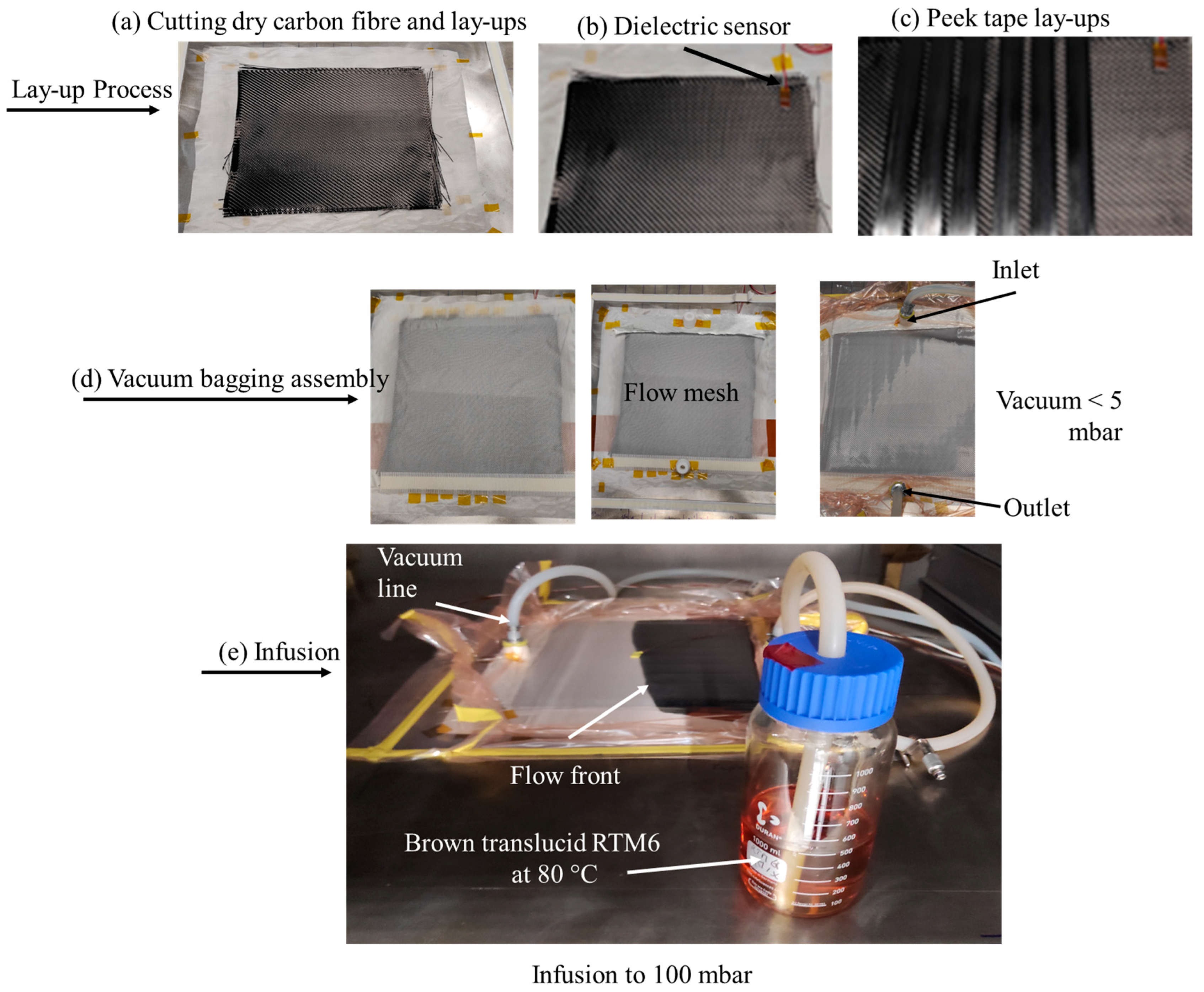
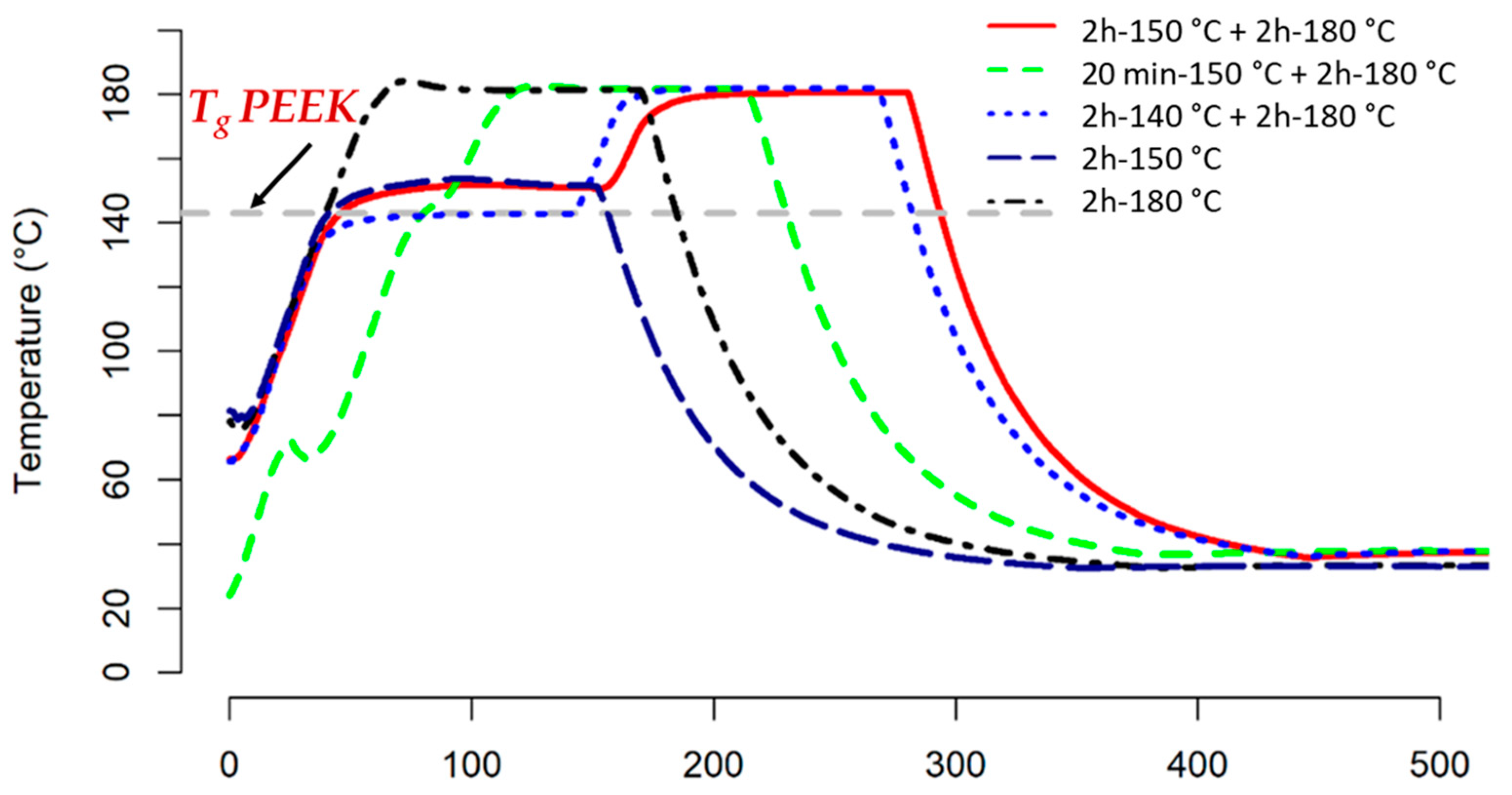
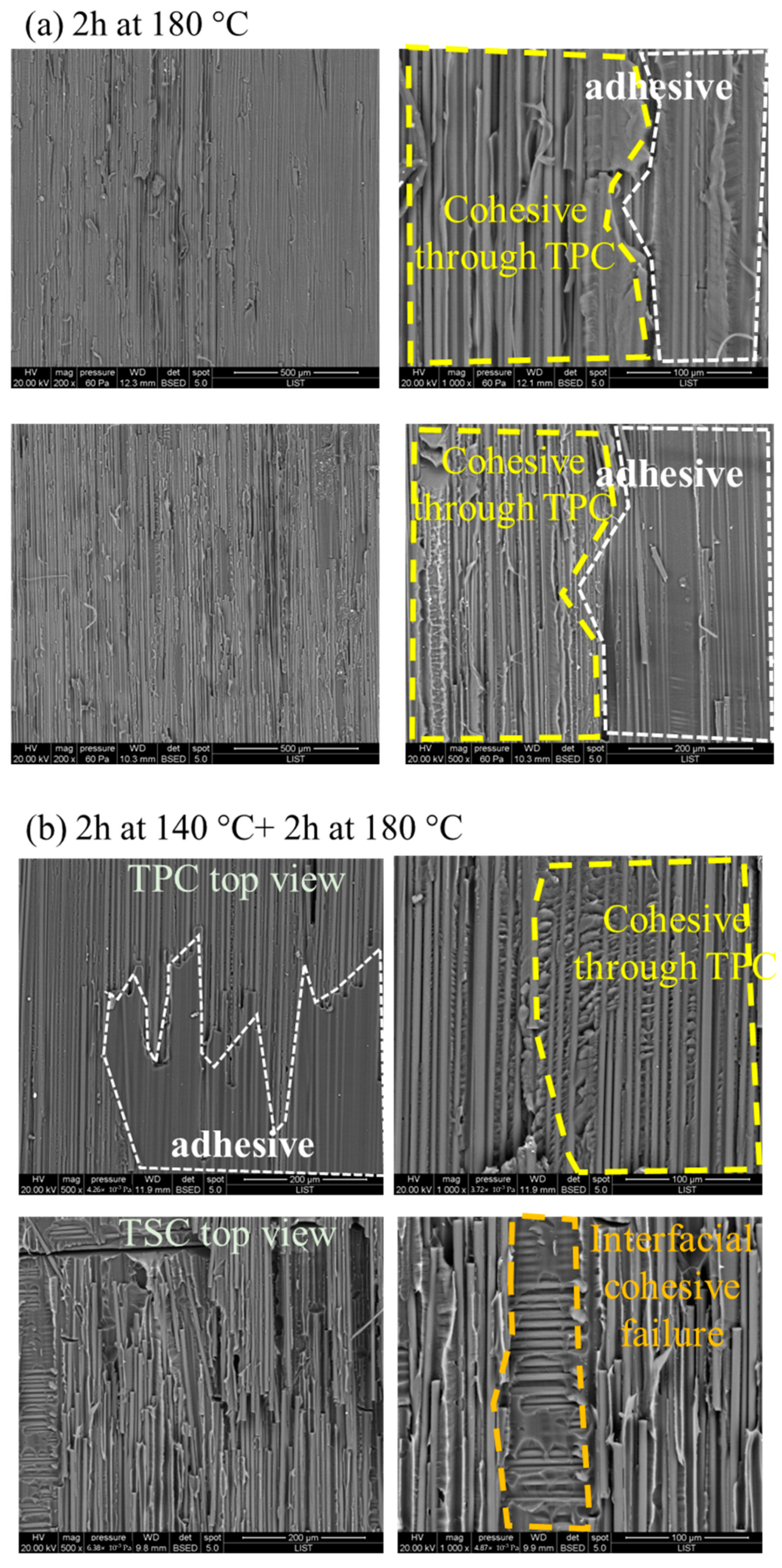
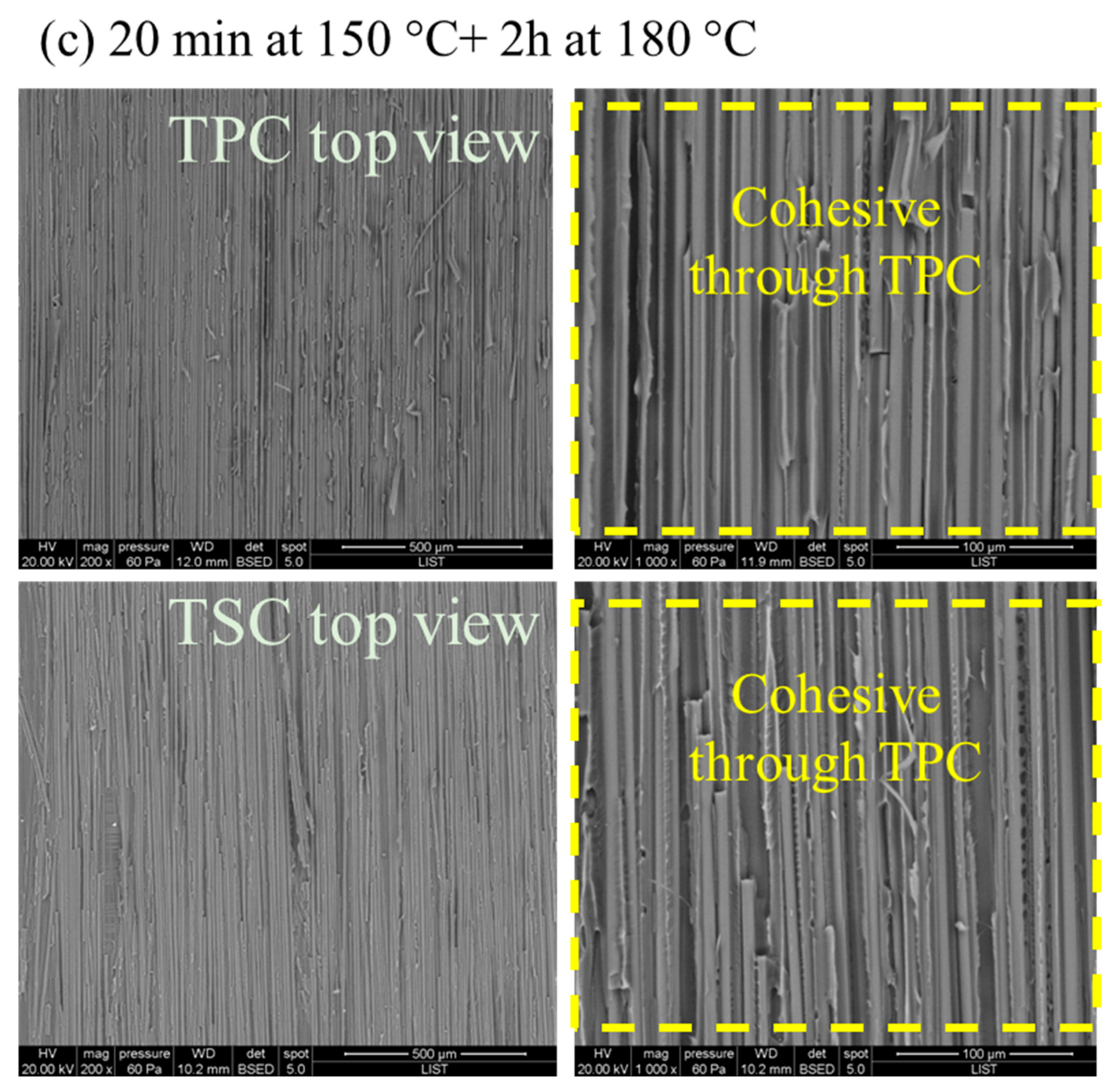
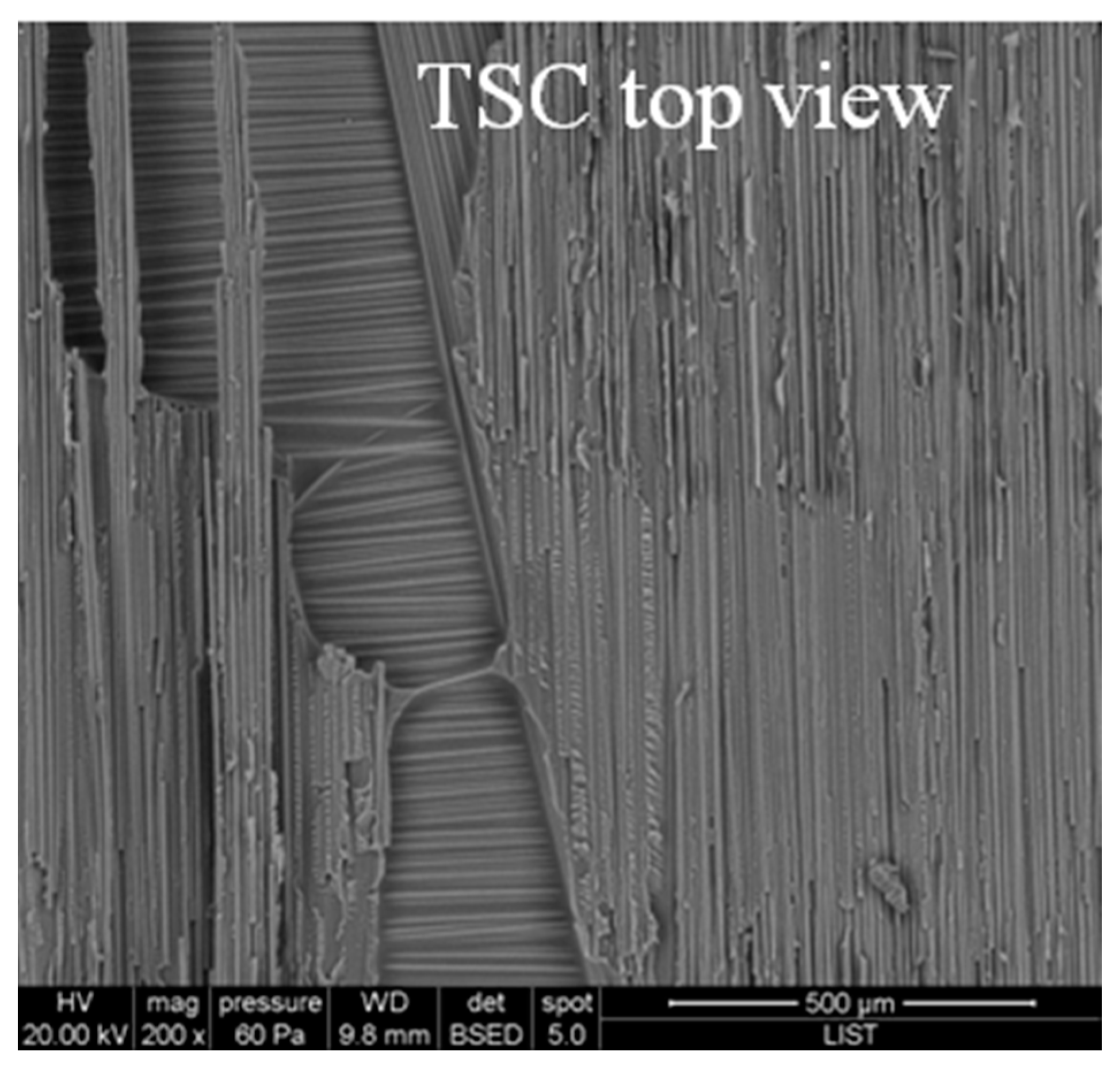
| Commercial Name | Characteristics | |||||
|---|---|---|---|---|---|---|
| Thickness (µm) | Fibre Fraction Volume (%) | Tg (°C) | Recrystallisation Temperature (°C) | Crystallinity (%) | Manufacturer | |
| Aptiv®2000 | 25 | 54 | 143 | 160 | 8 | Victrex® |
| Commercial Name | Characteristics | ||||
|---|---|---|---|---|---|
| Recommended Cure Cycle | Tg (°C) | Gel Time at 140 °C (min) | Resin Injection Temperature (°C) | Manufacturer | |
| HexFlow® RTM6-2 | 120 min at 180 °C | High | 95 | 80 under vacuum/ low pressure | Hexcel® |
| Style | Material | Number of Fibre | Weave Pattern | Areal Density |
|---|---|---|---|---|
| HexTow AS4C | Carbon fibre | 3K | 2 × 2 twill | 200 g/m2 |
| Curing Cycle | Mean of Maximum Peel Forces (M) (N/mm) | Standard Deviation (sd) | Coefficient of Variation (sd/M × 100) |
|---|---|---|---|
| 2 h at 140 °C + 2 h at 180 °C | 2.10 | 0.5 | 21.9 |
| 20 min at 150 °C + 2 h at 180 °C | 1.71 | 0.45 | 25.4 |
| 2 h at 150 °C + 2 h at 180 °C | 1.37 | 0.2 | 15.2 |
| 2 h at 150 °C | 1.17 | 0.11 | 9.7 |
| 2 h at 180 °C | 1.22 | 0.071 | 5.7 |
Disclaimer/Publisher’s Note: The statements, opinions and data contained in all publications are solely those of the individual author(s) and contributor(s) and not of MDPI and/or the editor(s). MDPI and/or the editor(s) disclaim responsibility for any injury to people or property resulting from any ideas, methods, instructions or products referred to in the content. |
© 2023 by the authors. Licensee MDPI, Basel, Switzerland. This article is an open access article distributed under the terms and conditions of the Creative Commons Attribution (CC BY) license (https://creativecommons.org/licenses/by/4.0/).
Share and Cite
Perrin, H.; Vaudemont, R.; Bodaghi, M. On the Analyses of Cure Cycle Effects on Peel Strength Characteristics in Carbon High-Tg Epoxy/Plasma-Activated Carbon PEEK Composite Interfaces: A Preliminary Inquiry. Materials 2023, 16, 7340. https://doi.org/10.3390/ma16237340
Perrin H, Vaudemont R, Bodaghi M. On the Analyses of Cure Cycle Effects on Peel Strength Characteristics in Carbon High-Tg Epoxy/Plasma-Activated Carbon PEEK Composite Interfaces: A Preliminary Inquiry. Materials. 2023; 16(23):7340. https://doi.org/10.3390/ma16237340
Chicago/Turabian StylePerrin, Henri, Régis Vaudemont, and Masoud Bodaghi. 2023. "On the Analyses of Cure Cycle Effects on Peel Strength Characteristics in Carbon High-Tg Epoxy/Plasma-Activated Carbon PEEK Composite Interfaces: A Preliminary Inquiry" Materials 16, no. 23: 7340. https://doi.org/10.3390/ma16237340
APA StylePerrin, H., Vaudemont, R., & Bodaghi, M. (2023). On the Analyses of Cure Cycle Effects on Peel Strength Characteristics in Carbon High-Tg Epoxy/Plasma-Activated Carbon PEEK Composite Interfaces: A Preliminary Inquiry. Materials, 16(23), 7340. https://doi.org/10.3390/ma16237340






